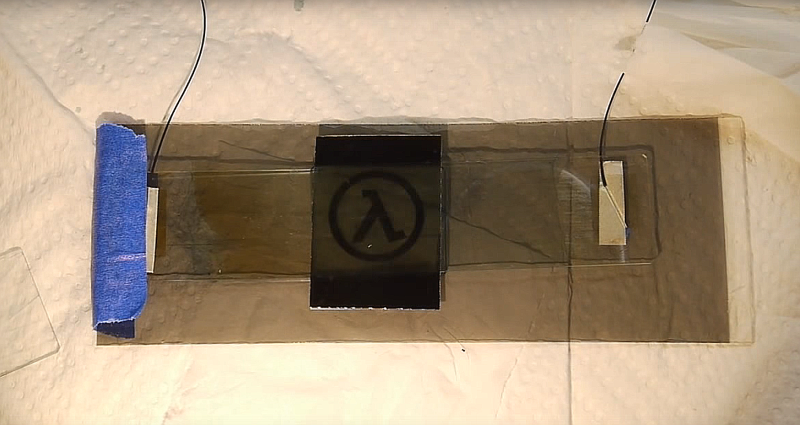If you have ever wondered what it took to make your own custom graphic LCD from scratch, this video from [Applied Science] is worth a watch. It’s concise and to the point, while still telling you what you need to know should you be interested in rolling your own. There is also a related video which goes into much more detail about experimenting with LCD technology.
[Applied Science] used microscope slides and parts purchased online to make an LCD that displays a custom graphic when activated. The only step that home experimenters might have trouble following is coating the glass slides with a clear conductive layer, which in the video is done via a process called sputtering to deposit a thin film. You don’t need to do this yourself, though. Pre-coated glass is readily available online. (Search for Indium-Tin Oxide or ‘ITO’ coated glass.)
The LCD consists of a layer of liquid crystal suspended between two layers of conductive glass. An electrical field is used to change the orientation of crystals in the suspension, which modulate the light passing through them. Polarizing filters result in a sharp contrast and therefore a visible image. To show a particular shape, some of the conductive coating is removed from one of the layers in the shape of the desired image. The process [Applied Science] uses to do this is nearly identical to etching a custom PCB.
Parts of LCD technology can be quite hackable. Neither of these videos are brand-new, either. Have any of you taken on the challenge of DIY LCD displays? We’ve seen experiments with electrochromatic glass using old LCD displays, as well as experiments in playing with polarized light to hide secret messages on LCD screens.
Thanks to [Samuel A. Falvo II] for the tip!
















this is…really old.
New to me. And very interesting. :)
I think you just carbon-dated yourself. :-) You’re not alone here. I remember when auto-reversing audio cassette tape decks were “radical”. :-) This is still cool technology and a joy to see for many, especially for those young pups out there who don’t know how to run a slide rule. :-)
http://hackaday.com/2013/12/02/crafting-a-liquid-crystal-display/
I’d glady learn how to auto reverse cassette tape deck! DO you have some info on it?
Decades ago, you could get liquid crystal gizmos. I can’t remember why you could buy them but Edmund Scientific was one place that sold them in the early seventies. This was before you saw LCDs as displays, though I’m not sure if they were already being used in expensive settings. Just little squares or discs, press on them and see some color, I can’t remember if they were heat sensitive. You can press an LCD display to this day and get the effect.
Michael
Like those weird shoes in the 90’s?
They make an LCD based scribble tablet now, pressure sensitive with electronic erase.
https://www.amazon.com/Boogie-Board-Writing-Tablet-Black/dp/B002ZE4TDI/189-2681826-1484900?ie=UTF8&*Version*=1&*entries*=0
come on. was featured here a loooong time ago.
http://hackaday.com/2013/12/02/crafting-a-liquid-crystal-display/
I know it’s not hacking as such, but I’d like to know the process to have an LCD made for you. You can get PCB’s made easily enough, are there similar services for LCDs?
Sure, you can get custom LCDs made but they charge for the tooling. That charge varies, I’ve seen it under 1000 USD but they need a volume commitment. Since the routing layer is really limited, they will dictate the pinout depending on where things end up. You can tell them which side to put the contacts on though. You also have to decide on the viewing angle so they know how to orient the polarizer. It’s something you do directly with the LCD manufacturer or through an agent, so in that respect it is a little like a PCB vendor.
Thanks Dielectric.
What is the tooling though?
In volume LCD manufacture, is the circuit produced lithographically as in this amateur one? Or is the indium conductive layer sputtered on through a mask, for example?
Are there standard LCD panel sizes?
Are there then standard pin-count packages (ie 2″ x 0.5″ 40-pin dip), whereby you layout your design to connect to the pins for that standard, etc, or is the entire thing entirely custom?
Having worked for a company that made products using custom LCDs… we certainly never looked for standard LCD panel sizes.
Connector-wise, you’re going to have some difficulty finding one that’s breadboard-friendly. Most are desired to just use a chunk of elastomer to a set of contacts on the PCB, and an external frame keeps things in good electrical contact. You can sometimes find ones that have a set of metal clips glued on in SIP or DIP: those are the most-nearly hacker-friendly.
You at least used to be able to find lots of bulk dot matrix controller-less glass from HD44780-like displays, but I think the economies of scale have mostly made those hard to get.
I have several of those HD44780 chipset displays! Every single one I got came from large copy-machines. Good luck finding large easily hacked monochrome displays now, I guess. Color has become cheap, but the older stuff is much more simple to deal with.
If I had the time and skill I would try to make a VFD from an old monitor. :)
I was thinking of making licence plate covers, for toll roads and such. but I gess not.
OH well
Besides the fact that its old, and still cool. It flashed 3 times omg :P